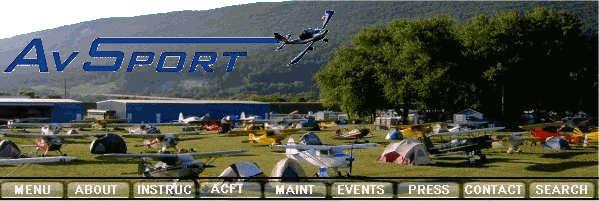
AvSport of Lock Haven -- 353 Proctor Street, Lock Haven PA 17745
Radios
Excerpt from Winging It! With Dr. Paul: Forty Tales Your Flight Instructor Never Told You (copyright © 1989 by H. Paul Shuch)

Radios
Excerpt from Winging It! With Dr. Paul: Forty Tales Your Flight Instructor Never Told You (copyright © 1989 by H. Paul Shuch)
I got together with Floyd Flyboy last week down at the local aerodrome, for his Bi-Decade Flight Review. Things were going great until I asked him a few questions about radio procedures. "Radio?" he asked. "What for? They haven't invented one yet which develops lift."
 He was only joshing, as I learned climbing aboard his ScareScraper, for there beneath the panel was a vintage Narco Super-Homer, powered by a miniature windmill between the main gear. Pepper grinder receiver and twelve transmit crystals, a reminder of what the Air Traffic Control System was like when the CAA reigned supreme.
He was only joshing, as I learned climbing aboard his ScareScraper, for there beneath the panel was a vintage Narco Super-Homer, powered by a miniature windmill between the main gear. Pepper grinder receiver and twelve transmit crystals, a reminder of what the Air Traffic Control System was like when the CAA reigned supreme.
"How do you know which transmit frequency to use?" I asked. "Simple," was his reply. "If I want to get someone's attention, I stick to 121.5."
Well, I thought, at least Floyd still knows the emergency frequency, but I wondered how he'd do with the rest of the band plan. "Plan?" he asked when I broached the subject. "You mean there's a plan as to how those 720 channels are assigned?"
"Well, not for all 720," I confessed, "but for a few, there's real madness to the method. And once you see the pattern, you can readily memorize the sixteen most useful frequencies."
I asked Floyd to write down a column of frequencies, starting at 121.5 and progressing in 100 kHz (that's .1 Meg) increments to 123.0. He recognized the first number on his list, of course, as the emergency frequency, and labeled it accordingly.
The next four frequencies, I told Floyd, are the ground control channels at most of the nation's controlled fields. There are exceptions, of course, but generally, if you're unsure of the ground channel, there are only four to try. And since they all start with "121" (just like the emergency frequency), controllers sometimes abbreviate, as in "Contact ground, point eight."
Next on the list comes 122.0, which is used nationwide for Enroute Flight Advisory Service, EFAS, better know as "flight watch." Anytime from 6 AM to 10 PM local, this is where you can get weather updates, check NOTAMs and file PIREPs. Only, when you call Flight Watch, be sure to specify where you are (nearest VOR or airport), so the appropriate facility can answer you.
The next six frequencies on the list, as Floyd learned, put you in touch with the friendly neighborhood Flight Service Station (remember, Service is their middle name), although only the first two are available everywhere. 122.1 is for you to transmit only. Tune in the nearest VOR on your nav receiver, turn up the volume, and tell FSS that's where you're listening, as in "Uptown Radio, this is Cesscraft 1234 Alpha, listening on the Midtown VOR." Most FSS facilities can contact you "through the VOR"; all can talk to you direct on 122.2, transmitting and receiving on the same frequency.
122.3 through 122.6 are similarly used for transmit and receive, with one of those frequencies assigned to each FSS. Your sectional chart tells you which one to use (in blue letters above the blue "FSS" box), but if in doubt, again there's only four to check. They are often used for traffic advisories at uncontrolled fields with an FSS on the premises.
The last four on the list, Floyd remembered, are all Unicom frequencies. He was aware that, in his local airspace, they use 122.7 at South County, 122.8 at both Frazier Lake and Watsonville, and 123.0 at Hollister. "Where do they use 122.9?" he asked. I told him that was Multicom, effectively the Unicom frequency for fields with no assigned Unicom frequency. If the sectional chart doesn't show a frequency for an uncontrolled field, that's the one to use for traffic advisories.
When we finished, Floyd's note paper looked like this:
| 121.5 | Emergency |
| 121.6 | Ground |
| 121.7 | Ground |
| 121.8 | Ground |
| 121.9 | Ground |
| 122.0 | Flight Watch |
| 122.1 | FSS (listen on the VOR) |
| 122.2 | All FSSs (transmit and receive) |
| 122.3 | Assigned FSS frequency |
| 122.4 | Assigned FSS frequency |
| 122.5 | Assigned FSS frequency |
| 122.6 | Assigned FSS frequency |
| 122.7 | Unicom |
| 122.8 | Unicom |
| 122.9 | Multicom |
| 123.0 | Unicom |
"Say, I don't even need the list now," commented Floyd. "Once you see the sequence, you can remember all the frequencies! Now, if only they could invent a radio that develops lift . . ."

If you can drive, you can fly!
Copyright © AvSport of Lock Haven, a subsidiary of Microcomm Consulting This page last updated 1 June 2010 |
Top of Page |